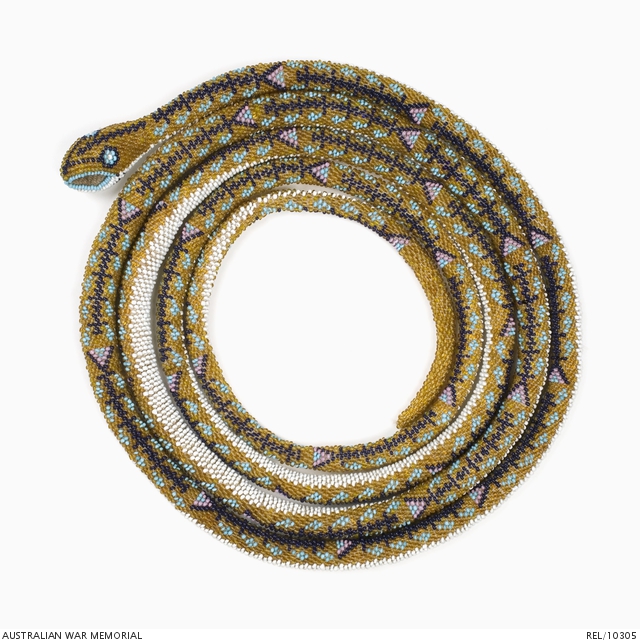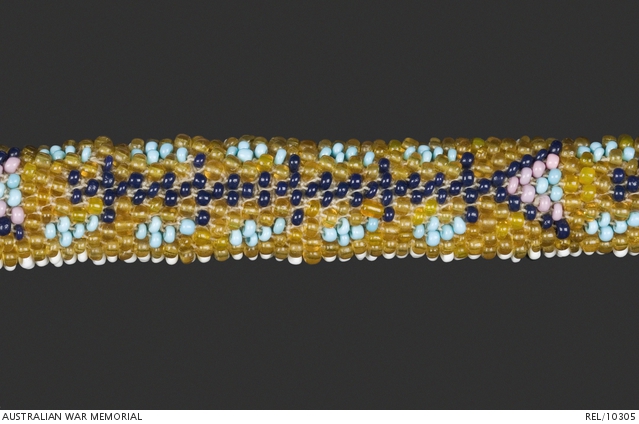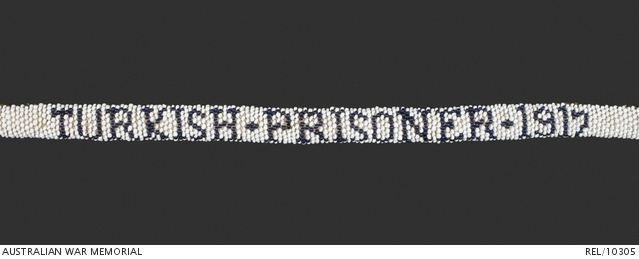| Places | |
|---|---|
| Accession Number | REL/10305 |
| Collection type | Heraldry |
| Object type | Heraldry |
| Physical description | Cotton, Glass |
| Maker |
Unknown |
| Place made | Egypt, Ottoman Empire: Palestine |
| Date made | 1917 |
| Conflict |
First World War, 1914-1918 |
Turkish Prisoner of War beadwork snake : Lance Corporal T E Anderson, 7 Sanitary Section, Anzac Mounted Division, AIF



Beaded crochet snake. The snake's back and tail are yellow, the belly is white. The snake's back has a design in light blue, dark blue and mauve beads, along the length of the body. The eyes of the snake are beaded in dark blue, light blue and white. Under the snake's lower jaw is the letter 'A' beaded in dark blue. 'TURKISH - PRISONER - 1917' is beaded on the snake's belly in dark blue. The snake's mouth is bordered with light blue beads, and the interior of the mouth is in plain cotton crochet. The top and bottom pointed ends of the mouth are sewn together.
This beadwork snake, made by an Ottoman prisoner of war (POW) in a British POW camp, probably in Egypt, was brought back to Australia as a souvenir of service by 16887 Lance Corporal Thomas Edward Anderson. Anderson enlisted in the AIF in Sydney on 5 July 1916 and after training with the Medical Corps left Australia for Egypt in January 1917 aboard the troopship HMAT A42 Boorara. He served initially with the Australian Camel Brigade Field Ambulance but transferred to 7th Sanitary Section Anzac Mounted Division in September 1917. Anderson was promoted to Lance Corporal in July 1918 and returned to Australia in March 1919.
Except for fatigue duties, prisoners were generally not required to work. Making craft items, along with playing sport, games or music helped them pass the time. The prisoners also made these items as a way of making some money to buy extra rations and supplies, such as coffee or tobacco; to barter with other prisoners; or as gifts for friends or family. Although many of the snakes produced in the camps have 'TURKISH PRISONER' beaded into their bellies, the maker may not have been ethnically Turkish as the Ottoman Empire stretched from the Balkans to the Sinai, and the soldiers in its armies came from throughout the empire. The bulk of the Memorial’s beadwork collection comes from Egypt but there were also prison camps in England, Salonika, Cyprus, Mesopotamia, India and France where prisoners made similar souvenirs. There are similarities in design, materials and technique in the beaded items made by prisoners which can make it difficult to know where the items were made. Snakes usually have a variation of a zigzag design or a diamond design on their backs. The bellies are generally white, often with text beaded in black or dark blue. Occasionally other colours are used. Some have decorative patterns, such as diamonds or triangles between the words on their bellies. The snakes were made using single stitch beaded crochet. To make the snakes, the beads had to be strung in order of the design before crocheting commenced. Some of the smaller beaded crochet items could be made with all the beads strung at once. The larger snakes had to be strung and made in sections, fastening the new thread to the worked one as the snake progressed. The snakes were stuffed with whatever materials were available, such as cotton thread, rags, or horsehair to keep their shape. The mouths are plain thread crocheted into two triangles that are attached to the snake. Snakes were amongst the most popular souvenirs made and sold. They were considered to bring good luck in parts of Southeast Europe, and there were many rituals and superstitions surrounding them, which could be why they were a popular subject. Their shape may have been another reason they were popular with POWs as they are essentially a long tube, which is relatively easy to make in crochet beadwork.